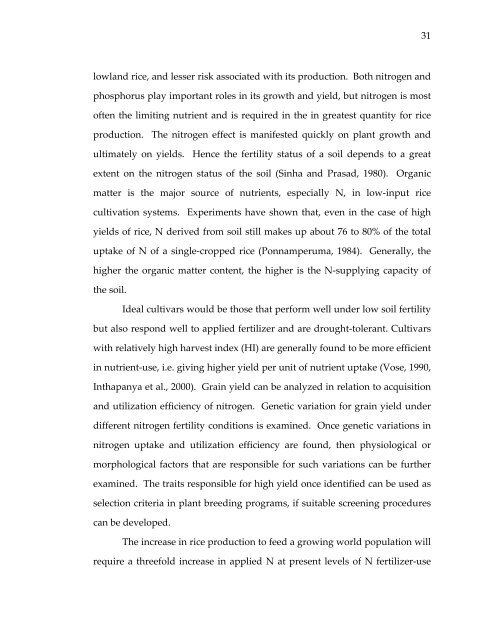Management of rice production systems to increase productivity
Management of rice production systems to increase productivity
Management of rice production systems to increase productivity
You also want an ePaper? Increase the reach of your titles
YUMPU automatically turns print PDFs into web optimized ePapers that Google loves.
lowland <strong>rice</strong>, and lesser risk associated with its <strong>production</strong>. Both nitrogen and<br />
phosphorus play important roles in its growth and yield, but nitrogen is most<br />
<strong>of</strong>ten the limiting nutrient and is required in the in greatest quantity for <strong>rice</strong><br />
<strong>production</strong>. The nitrogen effect is manifested quickly on plant growth and<br />
ultimately on yields. Hence the fertility status <strong>of</strong> a soil depends <strong>to</strong> a great<br />
extent on the nitrogen status <strong>of</strong> the soil (Sinha and Prasad, 1980). Organic<br />
matter is the major source <strong>of</strong> nutrients, especially N, in low‐input <strong>rice</strong><br />
cultivation <strong>systems</strong>. Experiments have shown that, even in the case <strong>of</strong> high<br />
yields <strong>of</strong> <strong>rice</strong>, N derived from soil still makes up about 76 <strong>to</strong> 80% <strong>of</strong> the <strong>to</strong>tal<br />
uptake <strong>of</strong> N <strong>of</strong> a single‐cropped <strong>rice</strong> (Ponnamperuma, 1984). Generally, the<br />
higher the organic matter content, the higher is the N‐supplying capacity <strong>of</strong><br />
the soil.<br />
Ideal cultivars would be those that perform well under low soil fertility<br />
but also respond well <strong>to</strong> applied fertilizer and are drought‐<strong>to</strong>lerant. Cultivars<br />
with relatively high harvest index (HI) are generally found <strong>to</strong> be more efficient<br />
in nutrient‐use, i.e. giving higher yield per unit <strong>of</strong> nutrient uptake (Vose, 1990,<br />
Inthapanya et al., 2000). Grain yield can be analyzed in relation <strong>to</strong> acquisition<br />
and utilization efficiency <strong>of</strong> nitrogen. Genetic variation for grain yield under<br />
different nitrogen fertility conditions is examined. Once genetic variations in<br />
nitrogen uptake and utilization efficiency are found, then physiological or<br />
morphological fac<strong>to</strong>rs that are responsible for such variations can be further<br />
examined. The traits responsible for high yield once identified can be used as<br />
selection criteria in plant breeding programs, if suitable screening procedures<br />
can be developed.<br />
The <strong>increase</strong> in <strong>rice</strong> <strong>production</strong> <strong>to</strong> feed a growing world population will<br />
require a threefold <strong>increase</strong> in applied N at present levels <strong>of</strong> N fertilizer‐use<br />
31
















